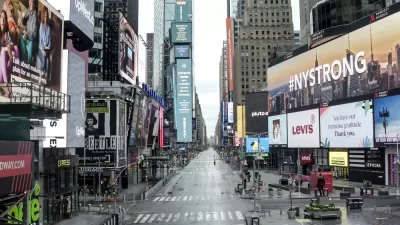Despite some transformative changes and brief spikes in domestic migration, the Covid-19 pandemic seems to be exacerbating existing declines in internal mobility.

A new brief from Riordan Frost of the Joint Center for Housing Studies of Harvard University updates Frost’s prior research on residential migration in the United States, revealing new insights about migration since the start of the pandemic and how it compares to previous trends.
Frost explains that “residential mobility rates have been declining for the past four decades,” and, aside from two spikes in the first year of the pandemic, trends stayed largely the same.
“One finding was that the types of moves and movers that had the steepest mobility rate declines before the pandemic remained the same during the pandemic.” Mobility rates declined across age, race, and ethnicity groups, but households with higher incomes were more likely to move. “Perhaps most notably, rural counties attracted more migrants than usual” as remote work untethered people from cities and high housing costs drove them farther out.
Monthly data allows for more nuanced analysis. “These data reveal that moves spiked twice early in the pandemic before reverting to pre-pandemic levels by the end of 2021 and falling further throughout 2022. As a result, USPS data show all types of moves—individual, family, permanent, and temporary—were lower in 2022 than before the pandemic.” Interestingly, “there were no mobility spikes during later surges like those associated with the Delta and Omicron variants.”
Frost concludes that “The paradigm-shifting nature of the pandemic makes it difficult to assess whether and how mobility patterns will change in coming years, but there are many factors pointing to a continued decline in mobility rates.”
FULL STORY: MOVING DURING THE PANDEMIC: MASS EXODUS OR MASS INERTIA?

Alabama: Trump Terminates Settlements for Black Communities Harmed By Raw Sewage
Trump deemed the landmark civil rights agreement “illegal DEI and environmental justice policy.”

Study: Maui’s Plan to Convert Vacation Rentals to Long-Term Housing Could Cause Nearly $1 Billion Economic Loss
The plan would reduce visitor accommodation by 25% resulting in 1,900 jobs lost.

Planetizen Federal Action Tracker
A weekly monitor of how Trump’s orders and actions are impacting planners and planning in America.

Waymo Gets Permission to Map SF’s Market Street
If allowed to operate on the traffic-restricted street, Waymo’s autonomous taxis would have a leg up over ride-hailing competitors — and counter the city’s efforts to grow bike and pedestrian on the thoroughfare.

Parklet Symposium Highlights the Success of Shared Spaces
Parklets got a boost during the Covid-19 pandemic, when the concept was translated to outdoor dining programs that offered restaurants a lifeline during the shutdown.

Federal Homelessness Agency Places Entire Staff on Leave
The U.S. Interagency Council on Homelessness is the only federal agency dedicated to preventing and ending homelessness.
Urban Design for Planners 1: Software Tools
This six-course series explores essential urban design concepts using open source software and equips planners with the tools they need to participate fully in the urban design process.
Planning for Universal Design
Learn the tools for implementing Universal Design in planning regulations.
Caltrans
Smith Gee Studio
Institute for Housing and Urban Development Studies (IHS)
City of Grandview
Harvard GSD Executive Education
Toledo-Lucas County Plan Commissions
Salt Lake City
NYU Wagner Graduate School of Public Service





























